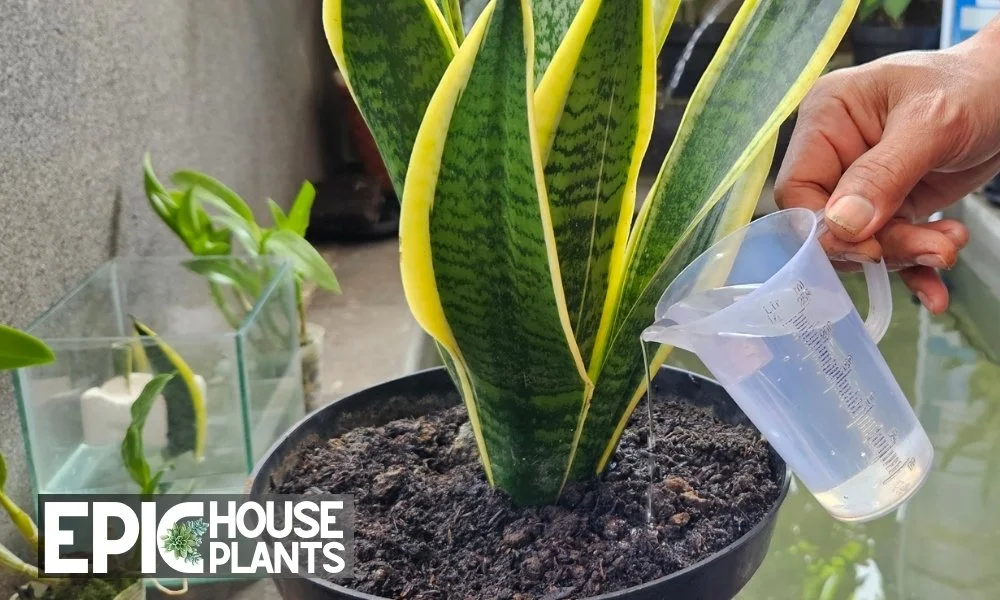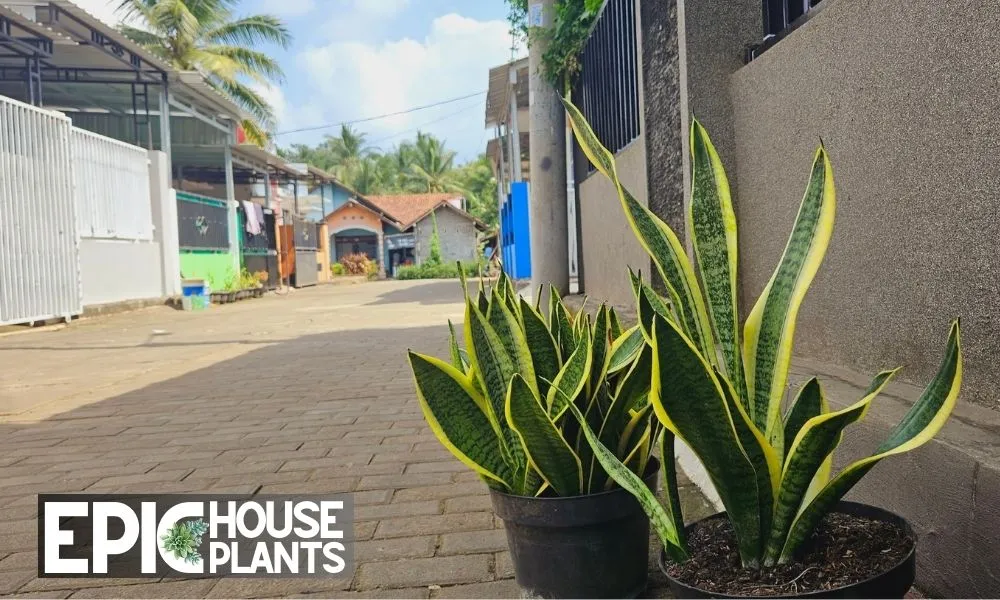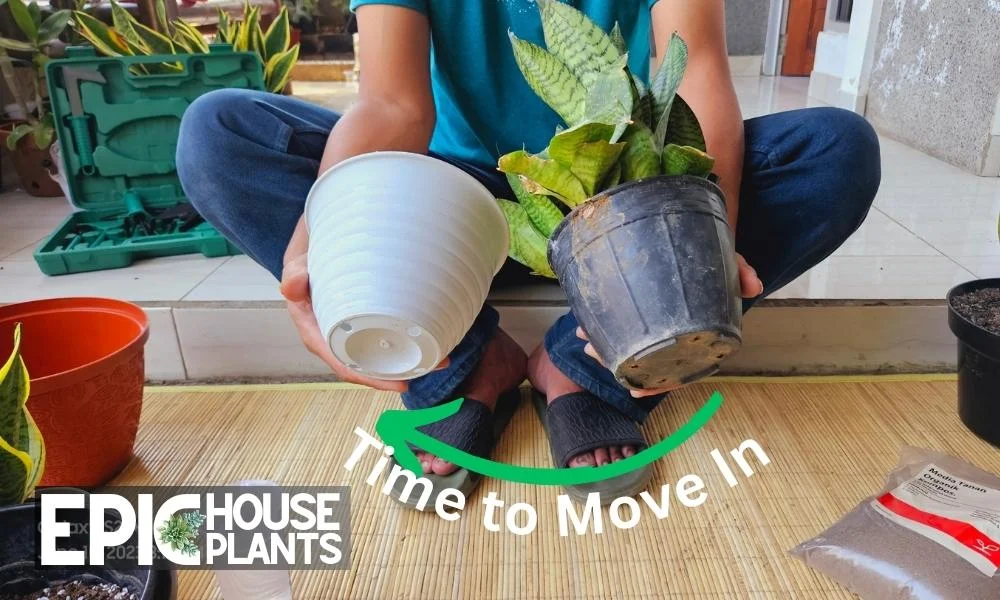Gardening can be an adventure, filled with life, growth, and sometimes a dash of mystery.
One such puzzle for the green-thumbed among us is the proper care of the snake plant, also known as Sansevieria or mother-in-law’s tongue. It’s well-loved for its robustness and unique appearance.
But, how often should you water a snake plant?
The real answer for the questions is to water them when the soil gets dry. It could be once a week, every two weeks, or even once a month.
Keep on reading, this article will guide you through the key tips to water your Snake Plant properly, helping it flourish in your care.

Factors That Influence Watering Frequency
Let’s unravel the various elements that can affect the frequency of watering your beloved snake plants.
Seasonal Changes: Nature’s Own Rhythm
Seasons play a significant role in determining how frequently you should water your plants. Spring and summer, typically the growing seasons, are when your plants are most active.
They’re busy photosynthesizing, growing, and blooming. Consequently, they require more water to fuel these activities.
On the other hand, during autumn and winter, plants often enter a dormant stage, slowing their growth and conserving resources. Watering should be reduced accordingly during these colder, quieter months.
Temperature and Humidity: The Invisible Influencers
The temperature and humidity levels in your environment are the unseen forces that influence your plant’s watering schedule.
Warmer temperatures and lower humidity often lead to faster evaporation of water from the soil and the plant itself, meaning you’ll need to water more frequently.
Conversely, cooler temperatures and higher humidity slow down evaporation, lessening the plant’s water demands.
Indoor or Outdoor Placement: The Home Versus The Wild
Where your plant resides — indoors or outdoors — has a big impact on its watering needs. Outdoor plants are more exposed to the elements, including wind, sunlight, and rainfall, which can all affect soil moisture levels.
Indoor plants, meanwhile, live in a more controlled environment. However, they may be affected by factors like indoor heating or air conditioning, which can dry out the soil faster.
Soil Type: The Water Holding Champion
Soil isn’t just dirt; it’s the lifeblood of your plant, providing nutrients and water. Different types of soil have different water-holding capacities.
For instance, sandy soil drains water quickly and needs frequent watering, while clay soil retains water for a longer time and requires less frequent watering.
A well-draining soil mix — usually recommended for most houseplants — strikes a balance, ensuring that your plants get enough water without becoming waterlogged.
Plant Size and Pot Size: The Big and Small of It
Last but not least, the size of both the plant and its pot contributes to watering frequency. Larger plants and those in bigger pots typically hold more soil, which in turn retains more water.
Hence, they might not need watering as often as smaller plants or those in smaller pots. However, it’s essential to ensure that the pot size is appropriate for the plant.
A plant in a too-large pot can easily become waterlogged, while one in a too-small pot may dry out too quickly.
A Seasonal Guide to Watering Your Snake Plant

When it comes to watering this resilient beauty, though, there’s a twist. You see, snake plants prefer their soil a little on the dry side. Overwatering is actually a common cause of snake plant demise.
Let’s dive into the seasonal watering guide to keep your snake plant happy and thriving all year round.
Spring: The Wake-Up Call
After the cold and sleepy winter, your snake plant enters into spring with renewed energy. During this time, the plant focuses on growth and therefore requires more frequent watering than in winter.
Typically, watering it every 7-14 days would be suitable, depending on the humidity and temperature of your home. However, it’s always crucial to check the soil before you grab that watering can.
If the top two inches of the soil are still moist, hold off on the water for a couple more days. Snake plants are drought-tolerant and would rather be a bit dry than too wet.
Summer: The Growing Season
Come summer, your snake plant will be in its active growing phase. This is when it’s working hard, photosynthesizing like a champ, and producing new leaves. Given these conditions, you should water your snake plant every 2 weeks.
However, this is not a hard-and-fast rule. The frequency of watering may decrease if your region is experiencing a particularly humid summer. Again, the “top two inches” rule of thumb applies here. If the soil’s top layer feels dry, go ahead and water it thoroughly.
Autumn: The Slowdown
As the summer fades, and the temperature starts to drop, your snake plant’s growth slows down. Its water needs lessen, so you should reduce the watering frequency. Typically, watering it once every 3 to 4 weeks should be adequate.
However, as we always say, let the soil be your guide. If it still feels moist, you can postpone watering for a few more days.
Winter: The Hibernation
During winter, your snake plant goes into a kind of hibernation. It slows down its growth and conserves its resources to survive the cold months. During this period, water your snake plant sparingly, perhaps once a month or even more.
The goal here is to prevent the soil from becoming waterlogged and freezing, which can damage the roots.
Author Note:
While the snake plant is a hardy specimen, it still has its preferences. It likes its water, but in moderation. And that moderation changes with the seasons.
Remember, it’s always better to underwater than overwater your snake plant. And when in doubt, check the soil. That’s your best bet in understanding what your green friend needs
How to Accurately Measure Soil Moisture for Your Snake Plant
This section provides a simple guide to accurately measuring soil moisture for your snake plant, ensuring it remains a healthy and thriving member of your indoor jungle.
Understanding Soil Moisture through Touch
It’s the simplest method, yet remarkably effective—just use your finger. To measure soil moisture using your finger, plunge it about 1-2 inches into the soil surrounding your snake plant.
If the soil feels dry or it easily falls off your finger upon removing it, it’s likely that the soil is too dry. Your snake plant is sending you a message—it’s thirsty!
Using a Moisture Meter
For a more scientific approach, consider using a moisture meter. This handy little device measures soil moisture levels on a scale from 1 to 10: 1-3 being dry, 4-7 moist, and 8-10 wet.
Ideally, you want to water your snake plant when the meter reads 3 or less. Just stick the moisture meter into the soil, and let the magic of science do the rest.
Author Note:
By accurately measuring the soil moisture, you’ll be able to ensure your snake plant receives just the right amount of water—not too little, not too much, but just right.
Top Tips for Watering Your Snake Plant Properly

We’ll explore some essential tips on how to water your Snake Plant properly.
Picking the Right Potion: Rain or Spring Water
While many plants can tolerate tap water, Snake Plants prefer the real deal—rainwater or spring water.
If possible, avoid using tap water, which often contains chlorine and other chemicals that can harm your plant over time.
Try to collect rainwater or use spring water to give your Snake Plant the pure hydration it craves.
Aim Right: Water the Soil, Not the Leaves
It’s essential to water the soil around the base of the Snake Plant, not the leaves. Watering the leaves can lead to rot, especially if the water sits on the leaves for too long.
Make sure to aim your watering can at the soil around the plant’s base, ensuring the water gets to the roots, where it’s most needed.
Choose the Right Vessel: Consider Terracotta

When it comes to picking the right pot for your Snake Plant, size and material matter. Terracotta pots, known for their porous nature, are an excellent choice.
They allow the soil to dry out more evenly between waterings and help prevent waterlogging. Make sure your pot has drainage holes—these are critical for preventing water buildup that can lead to root rot.
Thorough Watering: Wait Till It Drains
When watering your Snake Plant, make sure you water it thoroughly, until the water drains out from the drainage holes at the bottom of the pot. This method ensures that the water reaches all parts of the root system, giving your plant a good drink.
Top versus Bottom Watering
This guide will explore the best ways to water your snake plants, delving into the merits of both top and bottom watering.
Can Snake Plants Be Bottom Watered? The Deep Dive Method
The answer is a resounding yes! In fact, snake plants can greatly benefit from bottom watering every few weeks to give them a deep soak.
This method involves placing your snake plant in a shallow container, a sink, or even a bathtub filled with about an inch (2.5 cm) of water.
The idea is to allow the plant to draw water up from the bottom, encouraging deep root growth and ensuring that the water reaches all areas of the root system.
To bottom water your snake plant, first check that the drainage holes in your pot are clear. Then, place the pot in the water-filled container and let it sit for around 30 minutes, or until you notice the top of the soil is moist.
When the plant has absorbed enough water, remove it from the container and let any excess water drain out before returning it to its usual spot.
Can You Water a Snake Plant from the Top? The Traditional Technique
Absolutely! Top watering is the most common method and it’s perfectly acceptable for snake plants. It’s pretty straightforward:
You water the plant from the top, allowing the water to seep down through the soil and exit through the drainage holes at the bottom of the pot.
When using this method, make sure to water evenly around the base of the plant to ensure that all roots get their share of water. However, avoid getting water on the leaves, as this can lead to rot, especially in the cooler months.
Always remember, when it comes to snake plants, less is more. Overwatering can lead to soggy soil and root rot, which can be fatal to your plant.
Bottom vs Top: Which One Tops the Chart?
Here is a comparative table highlighting the pros and cons of both bottom watering and top watering for your snake plant:
| Bottom Watering | Top Watering | |
|---|---|---|
| Pros | Ensures deep hydration and encourages root growth. | Quick and easy. |
| Helps flush out salts and minerals. | Familiar method that doesn’t require additional equipment. | |
| Reduces risk of leaf rot, as water doesn’t touch the leaves. | Allows for spontaneous watering as needed. | |
| Cons | Time-consuming, especially with multiple plants. | Can lead to uneven water distribution. |
| Requires a suitable container large enough for the pot. | Risk of water sitting on leaves, which can cause rot. | |
| May not remove all debris or pests on the topsoil. | Overwatering can lead to soggy soil and root rot. |
Author Note:
The best watering strategy for your snake plant could involve using both methods. You might top water your plant regularly for convenience and bottom water occasionally to ensure deep hydration and health of the plant.
Recognizing Signs of Underwatering And Overwatering
Underwatering Signs
Despite their resilient nature, snake plants can exhibit signs of distress when they’re not receiving enough water.
These symptoms can include brown leaf tips, wilting or drooping leaves, leaves that are wrinkling, or leaves turning yellow or brown. If you notice any of these signs, it might be time to up your watering game.
Overwatering Signs
On the flip side, while it’s important to ensure your snake plant receives enough water, too much can also lead to problems—remember, balance is key. Overwatering your snake plant can result in the roots turning a concerning brown color.
You may also notice stagnation in your plant’s growth, with new leaves refusing to appear. Necrotic spots may begin to appear on the leaves, and mold can start to emerge on the soil’s surface.
Worst of all, overwatering may cause a rotten smell to emanate from your plant, which is never a good sign. In the most severe cases, both young and old leaves may start dropping simultaneously.
FAQs
How much water does snake plants need?
Snake Plants are a type of succulent, meaning they don’t require as much water as some other houseplants.
When watering, only apply enough water until the pot begins to drain from the bottom; anything more is excessive. Aim for damp soil—not bone-dry, but not completely saturated either.
Should You Mist Snake Plants? Not Really!
While some houseplants love a good misting, Snake Plants aren’t one of them. Misting can cause excess water to be absorbed through the leaves, leading to overwatering. So, leave the misting bottle aside when caring for your Snake Plant.
Final Words
Just like the love and effort we put into nurturing our relationships with family and friends, providing the right care for your Snake Plant can make all the difference.
It’s all about the details: the type of water you use, where you aim your watering can, the pot you select, and how thoroughly you water. All these factors together make the perfect recipe for a vibrant and thriving Snake Plant.
Remember, as you meet the unique watering needs of your Snake Plant, you’re not only caring for a plant; you’re cultivating a bond with a beautiful life form. So embrace the journey of plant parenthood, and let your Snake Plant’s verdant leaves be a testament to your love and care.
Happy watering!
Author

Pudji Haryanto
Pudji Haryanto is a writer and urban farmer with a passion for cultivating plants. He has over 15 years of experience in agriculture and currently manages a 65,000 square foot rice-field and yard filled with various plants, including vegetables, spices, flowers, and garden plants.


